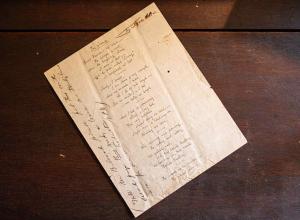The Morgan Library's Summer Americana Exhibit
New York, NY, June 4, 2012—The Morgan Library & Museum will open its vault again this summer for an exhibition of twenty-nine exceptional items from its permanent collections, including its noted holdings of important Americana. The works will go on view Tuesday, June 5 in the museum’s historic 1906 McKim building, and range from Noah Webster’s Dictionary manuscript, to revealing letters by Ernest Hemingway and James Madison, to music manuscripts by Mozart, Debussy, Schubert, and Haydn. The display will remain on view through September 8.
The items from American history are chosen with an eye towards celebrating the country’s achievements and struggles as the Fourth of July holiday approaches. The presentation’s centerpiece is the manuscript of a work familiar to all Americans, Noah Webster’s classic An American Dictionary of the English Language. Webster spent twenty-seven years and learned twenty-six languages in preparation for his Dictionary, which was finally published in 1828 when he was seventy years old. His was the first major American dictionary, and the last ever to be compiled by a single individual.
When George Washington delivered his inaugural address from the balcony of Federal Hall on Wall Street in April 1789, its content differed significantly from that of an earlier draft, a rare fragment of which is on view. In his draft, Washington praised the Constitution’s “balances arising from the distribution of the Legislative, Executive, and Judicial powers” and declared that “no government before introduced among mankind ever contained so many checks and such efficacious restraints to prevent it from degenerating into any species of oppression.”
Another Presidential writing, this one from James Madison, reminds us of a darker time in American history. Writing to the Marquis de Lafayette in November 1820—by which time slavery had become the most divisive issue in the republic—Madison observed, “All these perplexities develop more & more, the dreadful fruitfulness of the original sin of the African trade.”
Included among the other works from the Morgan’s collections of literature, rare books, music, and medieval art are the original manuscript of Oscar Wilde’s The Picture of Dorian Gray, revealing more overt homoerotic passages that were deleted before publication; an extremely rare set of fifteenth-century Italian tarot cards; Franz Schubert’s earliest surviving work, composed when he was just thirteen years old; and a fourteenth-century illustrated Arthurian legend of Lancelot.
??
The following is a complete list of the twenty-nine items on view in the McKim building this summer:
Americana
Jean Antoine Houdon's George Washington's Life Mask, 1785
James Madison’s letter to the Marquis de Lafayette, 1820
Henry David Thoreau's autograph journal, March 30-September 30, 1841
George Washington's inaugural address draft fragment, 1789
Noah Webster’s An American Dictionary of the English Language manuscript
Alexander Wilson’s American Ornithology with engravings by Alexander Lawson, 1828-29
??
Also on view
Breviary of Eleanor of Portugal, ca. 1500-10
Claude Debussy’s La Belle au bois dormant, 1890
Die geesten of geschiedenis van Romen (Deeds of the Romans), 1481
Raoul-Auger Feuillet’s Recueil de dances, 1700
Gospel Book, mid-tenth century
Gospel Book (“Mathilda Gospels”), end of the eleventh century
Joseph Haydn’s Symphony No. 91 in E-flat Major, 1788
Ernest Hemingway’s letter to George Plimpton of The Paris Review, 1954
Hyginus’s Poetica astronomica, 1485
Marianne Moore’s letter to Robert B. Young of the Ford Motor Company, 1955
Wolfgang Amadeus Mozart’s Piano Concerto in C Major, 1785
Vladimir Nabokov’s Stikhi (Poems), 1916
Ovid’s Les métamorphoses with engravings after Eisen, Gravelot, Boucher, and others, 1767-71
Samuel Pepys’s notes in shorthand, 1695
Edgar Allan Poe’s Tamerlane manuscript, 1828
Le roman de Lancelot du lac, ca. 1310-15
Franz Schubert’s Fantasie in G Major for Piano, 1810
Tarot cards from the Visconti-Sforza deck, ca. 1450
Samuel Taylor Coleridge’s manuscript commonplace book, ca. 1796
Paul Verlaine’s Parallèlement with lithographs by Pierre Bonnard, 1900
Jacopo Vignola’s Regola delli cinque ordini d’architettura, ca. 1564
Oscar Wilde’s manuscript of The Picture of Dorian Gray, 1889-90
The programs of The Morgan Library & Museum are made possible with public funds from the New York City Department of Cultural Affairs in partnership with the City Council, and by the New York State Council on the Arts with the support of Governor Andrew Cuomo and the New York State Legislature.
The Morgan Library & Museum
The Morgan Library & Museum began as the private library of financier Pierpont Morgan, one of the preeminent collectors and cultural benefactors in the United States. Today, more than a century after its founding in 1906, the Morgan serves as a museum, independent research library, musical venue, architectural landmark, and historic site. In October 2010, the Morgan completed the first-ever restoration of its original McKim building, Pierpont Morgan's private library, and the core of the institution. In tandem with the 2006 expansion project by architect Renzo Piano, the Morgan now provides visitors unprecedented access to its world-renowned collections of drawings, literary and historical manuscripts, musical scores, medieval and Renaissance manuscripts, printed books, and ancient Near Eastern seals and tablets.
General Information
The Morgan Library & Museum
225 Madison Avenue, at 36th Street
New York, NY 10016
212.685.0008
www.themorgan.org
Just a short walk from Grand Central and Penn Station
Hours
Tuesday-Thursday, 10:30 a.m. to 5 p.m.; extended Friday hours, 10:30 a.m. to 9 p.m.; Saturday, 10 a.m. to 6 p.m.; Sunday, 11 a.m. to 6 p.m.; closed Mondays, Thanksgiving Day, Christmas Day, and New Year's Day. The Morgan closes at 4 p.m. on Christmas Eve and New Year's Eve.
Admission
$15 for adults; $10 for students, seniors (65 and over), and children (under 16); free to Members and children 12 and under accompanied by an adult. Admission is free on Fridays from 7 to 9 p.m. Admission is not required to visit the Morgan Shop.

The items from American history are chosen with an eye towards celebrating the country’s achievements and struggles as the Fourth of July holiday approaches. The presentation’s centerpiece is the manuscript of a work familiar to all Americans, Noah Webster’s classic An American Dictionary of the English Language. Webster spent twenty-seven years and learned twenty-six languages in preparation for his Dictionary, which was finally published in 1828 when he was seventy years old. His was the first major American dictionary, and the last ever to be compiled by a single individual.
When George Washington delivered his inaugural address from the balcony of Federal Hall on Wall Street in April 1789, its content differed significantly from that of an earlier draft, a rare fragment of which is on view. In his draft, Washington praised the Constitution’s “balances arising from the distribution of the Legislative, Executive, and Judicial powers” and declared that “no government before introduced among mankind ever contained so many checks and such efficacious restraints to prevent it from degenerating into any species of oppression.”
Another Presidential writing, this one from James Madison, reminds us of a darker time in American history. Writing to the Marquis de Lafayette in November 1820—by which time slavery had become the most divisive issue in the republic—Madison observed, “All these perplexities develop more & more, the dreadful fruitfulness of the original sin of the African trade.”
Included among the other works from the Morgan’s collections of literature, rare books, music, and medieval art are the original manuscript of Oscar Wilde’s The Picture of Dorian Gray, revealing more overt homoerotic passages that were deleted before publication; an extremely rare set of fifteenth-century Italian tarot cards; Franz Schubert’s earliest surviving work, composed when he was just thirteen years old; and a fourteenth-century illustrated Arthurian legend of Lancelot.
??
The following is a complete list of the twenty-nine items on view in the McKim building this summer:
Americana
Jean Antoine Houdon's George Washington's Life Mask, 1785
James Madison’s letter to the Marquis de Lafayette, 1820
Henry David Thoreau's autograph journal, March 30-September 30, 1841
George Washington's inaugural address draft fragment, 1789
Noah Webster’s An American Dictionary of the English Language manuscript
Alexander Wilson’s American Ornithology with engravings by Alexander Lawson, 1828-29
??
Also on view
Breviary of Eleanor of Portugal, ca. 1500-10
Claude Debussy’s La Belle au bois dormant, 1890
Die geesten of geschiedenis van Romen (Deeds of the Romans), 1481
Raoul-Auger Feuillet’s Recueil de dances, 1700
Gospel Book, mid-tenth century
Gospel Book (“Mathilda Gospels”), end of the eleventh century
Joseph Haydn’s Symphony No. 91 in E-flat Major, 1788
Ernest Hemingway’s letter to George Plimpton of The Paris Review, 1954
Hyginus’s Poetica astronomica, 1485
Marianne Moore’s letter to Robert B. Young of the Ford Motor Company, 1955
Wolfgang Amadeus Mozart’s Piano Concerto in C Major, 1785
Vladimir Nabokov’s Stikhi (Poems), 1916
Ovid’s Les métamorphoses with engravings after Eisen, Gravelot, Boucher, and others, 1767-71
Samuel Pepys’s notes in shorthand, 1695
Edgar Allan Poe’s Tamerlane manuscript, 1828
Le roman de Lancelot du lac, ca. 1310-15
Franz Schubert’s Fantasie in G Major for Piano, 1810
Tarot cards from the Visconti-Sforza deck, ca. 1450
Samuel Taylor Coleridge’s manuscript commonplace book, ca. 1796
Paul Verlaine’s Parallèlement with lithographs by Pierre Bonnard, 1900
Jacopo Vignola’s Regola delli cinque ordini d’architettura, ca. 1564
Oscar Wilde’s manuscript of The Picture of Dorian Gray, 1889-90
The programs of The Morgan Library & Museum are made possible with public funds from the New York City Department of Cultural Affairs in partnership with the City Council, and by the New York State Council on the Arts with the support of Governor Andrew Cuomo and the New York State Legislature.
The Morgan Library & Museum
The Morgan Library & Museum began as the private library of financier Pierpont Morgan, one of the preeminent collectors and cultural benefactors in the United States. Today, more than a century after its founding in 1906, the Morgan serves as a museum, independent research library, musical venue, architectural landmark, and historic site. In October 2010, the Morgan completed the first-ever restoration of its original McKim building, Pierpont Morgan's private library, and the core of the institution. In tandem with the 2006 expansion project by architect Renzo Piano, the Morgan now provides visitors unprecedented access to its world-renowned collections of drawings, literary and historical manuscripts, musical scores, medieval and Renaissance manuscripts, printed books, and ancient Near Eastern seals and tablets.
General Information
The Morgan Library & Museum
225 Madison Avenue, at 36th Street
New York, NY 10016
212.685.0008
www.themorgan.org
Just a short walk from Grand Central and Penn Station
Hours
Tuesday-Thursday, 10:30 a.m. to 5 p.m.; extended Friday hours, 10:30 a.m. to 9 p.m.; Saturday, 10 a.m. to 6 p.m.; Sunday, 11 a.m. to 6 p.m.; closed Mondays, Thanksgiving Day, Christmas Day, and New Year's Day. The Morgan closes at 4 p.m. on Christmas Eve and New Year's Eve.
Admission
$15 for adults; $10 for students, seniors (65 and over), and children (under 16); free to Members and children 12 and under accompanied by an adult. Admission is free on Fridays from 7 to 9 p.m. Admission is not required to visit the Morgan Shop.

















